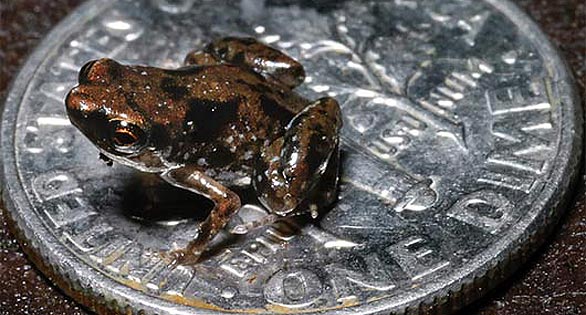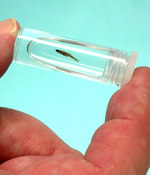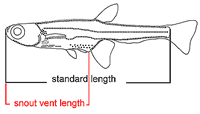
Measuring an incredible 7.7mm, this tiny frog from a New Guinea rainforest, sits on a US dime. Credit: Rittmeyer et al/ PLoS One
A friendly rivalry between different zoological camps has an ongoing disagreement about what, exactly, is the world’s smallest vertebrate.
Earlier in the year, amphibian experts announced the discovery of two tiny frog species in the rainforests of New Guinea, one measuring an average of just 7.7 mm, less than a third of an inch or the size of a plump housefly. In announcing the newly described species, two Louisiana State University scientists claimed the frog, Paedophryne amauensis, to be the world’s smallest know animal with a backbone.

Dr. Ralf Britz, ichthyologist at the British Natural History Museum, London: “A fish is still the smallest vertebrate!”
Now Dr. Ralf Britz, an ichthyologist with a special interest in tiny species at the British Natural History Museum in London, has posed a counter argument, saying that the use of consistent standards of measurement would place the Indonesian fish, Padeocypris progenetica, described in 2006, to the unofficial position of World’s Smallest Vertebrate. (The species was actually found in 1996 by Maurice Kottelat and Tan Heok Hui from the Raffles Museum of Biodiversity Research and the National University of Singapore.)
Living in acidic peat swamps of Sumatra, the smallest known fish measures 7.9 mm from tip of the snout to the base of the caudal (tail) fin, slightly larger than the smallest frog.
However, Britz points out that different standards are used by the amphibian researchers that put the fish at a disadvantage.
Standard Length
Standard Length (SL) and is used by fish researchers. ‘The reason we use the standard length rather than measure to the end of the fin is because the tips of caudal fin rays are frequently damaged or broken off, and so would give an incorrect measurement.’ (Measuring from tip to snout to tip of tail is the Total Length [TL] also cited in many references.)
Snout-Vent Length
Other animals are measured in different ways. For example, in frogs researchers measure the distance between the snout and the vent (anus), and this is known as the Snout-Vent Length.
“Measuring fish the same way would result in much shorter lengths,” says Dr. Britz. “For example the snout-vent length of the fish Paedocypris progenetica would be just 4.3mm and therefore much smaller than the frog Paedophryne amauensis, the species that is considered by some to be the smallest vertebrate!’
Close to the limit?
So, are we close to the smallest size that exists in nature? Britz thinks so. “Among vertebrates, I think we are getting very close to the lower size limit with the recent discoveries of tiny fishes, frogs, and reptiles.
“The same is true for insects. Regarding the other invertebrate groups there may be still a number of smaller species waiting to be discovered.”
Hazards to being tiny
One of the biggest drawbacks of being tiny is that you become prey to more predators, says Ralf. ‘While larger fish do not have to fear many invertebrate predators, a tiny fish like Danionella or Paedocypris could be easily eaten by aquatic beetles or dragonfly larvae.’

Paedocypris progenetica is shown to scale held inside a small tube. © Maurice Kottelat, Cornol /Raffles Museum
Another problem for tiny creatures, suggests Britz, is likely to be the number of offspring. Because egg size has a lower limit too, small animals produce less of them. So each individual produces fewer offspring, risky when your small size means you are already easy prey.
Why evolve so small?
Many tiny animals seem to evolve in unusual habitats. Britz explains, ‘There seems to be some correlation between special habitats and small size. Some of the smallest invertebrates live among grains of sand, are parasitic or, in the case of P progenetica, live in extremely acidic water.’
‘In the end becoming very small is just another way of adapting to the environment, as is being very big or being of regular size.’
With such a diversity of habitats on our planet, many of them unexplored, it’s likely that there’ll be more ‘smallest’ species discoveries to come.

World’s smallest known fish, from the acidic peat swamps of Sumatra. Credit: Natural History Museum, London.
So, just what is the smallest vertebrate?
Ralf concludes, “Applying the same way of measuring frogs to Paedocypris – that is, using the same landmarks – clearly demonstrates that the fish P. progenetica is still the smallest vertebrate!”
Sources
From materials released by the Natural History Museum (September, 2012).
Read more at: http://phys.org/news/2012-01-frog-species-world-smallest-vertebrate.html#jCp






